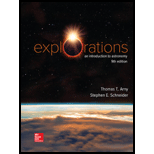
Concept explainers
What is light-gathering power? How does it affect the ability to see faint objects?
The light-gathering power, and to check its effect on the ability to see faint objects.
Answer to Problem 1QFR
Light-gathering power is the capability of a telescope to accumulate a large amount of photons than the human eye. The greater the area of collecting of the telescope the brighter the object.
Explanation of Solution
When photons from any object strike a person’s retina he or she will be capable to see the object if the quantity of photons are large enough to trigger chemical reactions in nerve cells. The brightness of the object is dependent on the number of photons that enter his or her eye per second, and the number differs according to the size of each person’s eyes pupils.
Light-gathering power rely on the collecting area of the mirror. In case of telescopes the greater its collecting area the more the photons it collects. Thus, a telescope with a larger diameter lens will have greater light-gathering power. Since a larger telescope can produce a brighter image, this allows a person to see faint stars that are invisible in telescopes with smaller gathering area.
Therefor light-gathering power is the capability of a telescope to collect a large amount of photons than the human eye. Also greater the area of collecting the brighter the object.
Want to see more full solutions like this?
Chapter 5 Solutions
EXPLORATIONS:INTRO.TO ASTRONOMY
- Describe the techniques radio astronomers use to obtain a resolution comparable to what astronomers working with visible light can achieve.arrow_forwardDescribe one visible-light or infrared telescope that astronomers are planning to launch into space in the future.arrow_forwardSuppose you are looking for sites for a visible-light observatory, an infrared observatory, and a radio observatory. What are the main criteria of excellence for each? What sites are actually considered the best today?arrow_forward
 AstronomyPhysicsISBN:9781938168284Author:Andrew Fraknoi; David Morrison; Sidney C. WolffPublisher:OpenStax
AstronomyPhysicsISBN:9781938168284Author:Andrew Fraknoi; David Morrison; Sidney C. WolffPublisher:OpenStax Stars and Galaxies (MindTap Course List)PhysicsISBN:9781337399944Author:Michael A. SeedsPublisher:Cengage Learning
Stars and Galaxies (MindTap Course List)PhysicsISBN:9781337399944Author:Michael A. SeedsPublisher:Cengage Learning
 Foundations of Astronomy (MindTap Course List)PhysicsISBN:9781337399920Author:Michael A. Seeds, Dana BackmanPublisher:Cengage Learning
Foundations of Astronomy (MindTap Course List)PhysicsISBN:9781337399920Author:Michael A. Seeds, Dana BackmanPublisher:Cengage Learning Horizons: Exploring the Universe (MindTap Course ...PhysicsISBN:9781305960961Author:Michael A. Seeds, Dana BackmanPublisher:Cengage Learning
Horizons: Exploring the Universe (MindTap Course ...PhysicsISBN:9781305960961Author:Michael A. Seeds, Dana BackmanPublisher:Cengage Learning





